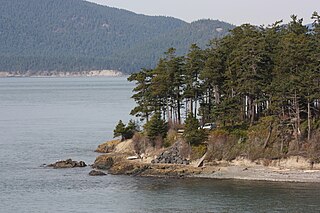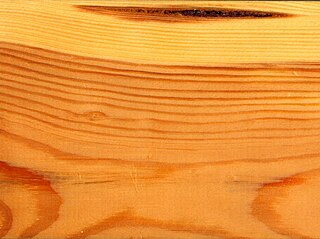
The Douglas fir is an evergreen conifer species in the pine family, Pinaceae. It is native to western North America and is also known as Douglas-fir, Douglas spruce, Oregon pine, and Columbian pine. There are three varieties: coast Douglas-fir, Rocky Mountain Douglas-fir and Mexican Douglas-fir.

Softwood is wood from gymnosperm trees such as conifers. The term is opposed to hardwood, which is the wood from angiosperm trees. The main differences between hardwoods and softwoods is that the softwoods completely lack vessels (pores). The main softwood species also have resin canals in their structure.

The Tortricidae are a family of moths, commonly known as tortrix moths or leafroller moths, in the order Lepidoptera. This large family has over 11,000 species described, and is the sole member of the superfamily Tortricoidea, although the genus Heliocosma is sometimes placed within this superfamily. Many of these are economically important pests. Olethreutidae is a junior synonym. The typical resting posture is with the wings folded back, producing a rather rounded profile.

Choristoneura fumiferana, the eastern spruce budworm, is a species of moth of the family Tortricidae native to the eastern United States and Canada. The caterpillars feed on the needles of spruce and fir trees. Eastern spruce budworm populations can experience significant oscillations, with large outbreaks sometimes resulting in wide scale tree mortality. The first recorded outbreaks of the spruce budworm in the United States occurred in about 1807, and since 1909 there have been waves of budworm outbreaks throughout the eastern United States and Canada. In Canada, the major outbreaks occurred in periods circa 1910–20, c. 1940–50, and c. 1970–80, each of which impacted millions of hectares of forest. Longer-term tree-ring studies suggest that spruce budworm outbreaks have been recurring approximately every three decades since the 16th century, and paleoecological studies suggest the spruce budworm has been breaking out in eastern North America for thousands of years.

Archips oporana, also known as the pine tortrix or spruce tortrix is a moth of the family Tortricidae, found in Asia and Europe. It was first described by Carl Linnaeus in 1758.

Argyrotaenia is a genus of moths in the tribe Archipini within the family Tortricidae.

Argyrotaenia pinatubana, the pine tube moth, is a species of moth of the family Tortricidae. It is found in eastern North America, from Canada south to Florida and west to Wisconsin.

Pseudotsuga menziesii var. menziesii, commonly known as Coast Douglas-fir, Pacific Douglas-fir, Oregon pine, or Douglas spruce, is an evergreen conifer native to western North America from west-central British Columbia, Canada southward to central California, United States. In Oregon and Washington its range is continuous from the Cascades crest west to the Pacific Coast Ranges and Pacific Ocean. In California, it is found in the Klamath and California Coast Ranges as far south as the Santa Lucia Mountains with a small stand as far south as the Purisima Hills, Santa Barbara County. In the Sierra Nevada it ranges as far south as the Yosemite region. It occurs from near sea level along the coast to 1,800 metres (5,900 ft) in the California Mountains. Further inland, coast Douglas-fir is replaced by Rocky Mountain or interior Douglas-fir. Interior Douglas-fir intergrades with coast Douglas-fir in the Cascades of northern Washington and southern British Columbia.
Argyrotaenia montezumae is a species of moth of the family Tortricidae. It is found in Guatemala, Mexico and the United States, where it has been recorded from Arizona and New Mexico.
Argyrotaenia kimballi, Kimball's leafroller moth, is a species of moth of the family Tortricidae. It is found in the United States, where it has been recorded from Alabama, Florida, Louisiana, Maryland, Mississippi, North Carolina, South Carolina, Tennessee and Texas.

Argyrotaenia tabulana, the jack pine tube moth or lodgepole needletier moth, is a species of moth of the family Tortricidae. It is found in North America, where it has been recorded from Alabama, Arkansas, British Columbia, Florida, Georgia, Indiana, Louisiana, Maine, Maryland, Massachusetts, Mississippi, New Jersey, New York, North Carolina, Ohio, Oklahoma, Pennsylvania, South Carolina and West Virginia.
Argyrotaenia repertana is a species of moth of the family Tortricidae. It is found in North America, where it has been recorded from Maine, Manitoba, Massachusetts, New Brunswick, Nova Scotia, Quebec, Saskatchewan and Washington.

Argyrotaenia juglandana, the hickory leafroller moth, is a species of moth of the family Tortricidae. It is found in North America, where it has been recorded from Alabama, Arkansas, Florida, Illinois, Indiana, Kentucky, Louisiana, Maryland, Mississippi, Missouri, New Hampshire, New York, North Carolina, Ohio, Ontario, Pennsylvania, Quebec, Tennessee, Texas, West Virginia and Wisconsin. The habitat consists of deciduous woodlands and parks where hickory grows.

Argyrotaenia coloradanus is a species of moth of the family Tortricidae. It is found in the United States, where it has been recorded from Arizona, Colorado, Nevada, New Mexico, Utah and Wyoming.
Argyrotaenia cupressae is a species of moth of the family Tortricidae. It is found in the United States, where it has been recorded from California.
Argyrotaenia lautana is a species of moth of the family Tortricidae. It is found in the United States, where it has been recorded from Arizona and California. It is also found in Mexico.

Argyrotaenia provana is a species of moth of the family Tortricidae. It is found in North America, where it has been recorded from Arizona, British Columbia, California, Colorado, New Mexico, Utah, Washington and Wyoming.
Argyrotaenia niscana is a species of moth of the family Tortricidae. It is found in the United States, where it has been recorded from California and Mississippi.
Argyrotaenia quadrifasciana, the four-lined leafroller moth, four-banded leafroller or lesser all-green leafroller, is a species of moth of the family Tortricidae. It is found in North America, where it has been recorded from Nova Scotia to West Virginia, west to Arkansas and north to Alberta. The habitat consists of orchards and shrubby areas.
Argyrotaenia occultana, the fall spruce needle moth, is a moth of the family Tortricidae. The species was first described by Thomas Nesbitt Freeman in 1942. It is found in North America, where it has been recorded from British Columbia north to Yukon and Northwest Territories, east to Newfoundland and south to Kentucky and Oregon. The habitat consists of spruce forests.













